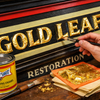The Art of Kintsugi - Embracing Imperfection with Gold
- by Sam Wozniak
What is Kintsugi?
Kintsugi is the centuries-old Japanese art of repairing broken pottery using lacquer mixed with precious metals, most notably gold. Rather than hiding cracks or imperfections, Kintsugi embraces them—highlighting the beauty in restoration and imperfection.
This powerful philosophy aligns beautifully with the practice of gilding, especially when incorporating materials such as gold leaf, 24 carat shell gold, and gold powder. In this guide, we’ll explore the techniques, materials, and meaning behind Kintsugi and how beginners can get started using authentic goldleaf.
Click here to see a list of Kintsugi supplies recommended by our gilding experts!
1. The Philosophy Behind Kintsugi
Kintsugi, which translates to “golden joinery,” is more than a craft—it's a mindful practice. Rooted in the Japanese philosophy of wabi-sabi, it finds beauty in impermanence and flaws. When a ceramic item breaks, it’s not discarded—it’s lovingly repaired, and the repair itself becomes part of its story.
This makes Kintsugi a meditative and meaningful art, ideal for those looking to combine craftsmanship with personal reflection or mindfulness.
2. Essential Materials for Kintsugi
There are modern and traditional versions of Kintsugi, but when aiming for authenticity and luxury, these materials are key:
-
Urushi lacquer (or modern substitutes): Acts as both adhesive and filler.
-
Gold powder: The traditional finish sprinkled over the lacquer.
-
Shell gold or gold leaf: Higher-end options used for enhancing joints.
-
Ceramic or porcelain pieces: Broken but valued.
-
Soft brush: To apply gold. (We recommend: Series 1335 Sable Artists Pencils)
-
Putty or epoxy (for beginners): Easier to handle than lacquer.
24 carat gold leaf or shell gold is highly sought after for Kintsugi because of its purity, shine, and symbolism. Shell gold—a powdered gold pigment bound with gum arabic—is especially suited for detailed touch-ups and brush applications.
3. Gold Leaf vs. Gold Powder vs. Shell Gold in Kintsugi
When choosing between different gilding materials for Kintsugi, it’s important to understand the role each plays:
-
Gold powder:: Traditionally used and offers a fine dusting of gold that can be applied with a brush or sprinkled.
-
24 Carat Gold Leaf: Luxurious and luminous, it can be applied along cracks with lacquer for a bold, golden effect.
-
Shell gold: Ideal for precise detailing, especially when painting over seams. It has a beautiful matte finish and is easier to control with a brush.
Each of these goldleaf forms adds its own aesthetic and can be chosen based on the scale and style of the repair.
4. Step-by-Step Guide to Modern Kintsugi with Gold Leaf
Here’s a simplified process for beginners using a modern approach with 24 carat gold leaf or shell gold:
Step 1: Clean and Prepare
Carefully clean the broken ceramic pieces. Lightly sand the edges if necessary to ensure smooth adhesion.
Step 2: Bond the Pieces
Use a two-part epoxy or traditional urushi lacquer to bond the broken parts together. Let it cure as per the product instructions.
Step 3: Fill and Smooth Cracks
Fill in the cracks with a mix of lacquer and a fine filler if needed. Once dry, sand the filled areas to ensure a smooth finish.
Step 4: Apply Gilding Size or Lacquer
Use a fine brush to apply a small amount of adhesive or lacquer over the repaired seams.
Step 5: Add Gold
-
For gold powder: Dust the gold powder carefully over the adhesive.
-
For gold leaf: Lay thin strips along the seams. 24 carat gold leaf gives a brilliant shine and authentic touch.
-
For shell gold: Paint the seams delicately using a brush dipped in shell gold mixture.
Step 6: Seal and Protect (Optional)
Once dry, apply a gentle sealant if using gold leaf or powder to protect the surface, especially if the piece will be used regularly.
5. Where to Buy Quality Kintsugi Supplies
For a truly elevated Kintsugi experience, using authentic goldleaf, shell gold, and 24 carat gold powder is essential. Reputable suppliers like Wrights of Lymm offer fine gilding materials perfect for this craft.
Look for:
-
24 carat loose leaf gold
-
Genuine shell gold in pans
-
High-purity gold powder
-
Fine detail gilding brushes
Avoid imitation products if you aim for longevity and authenticity.
6. Why Practice Kintsugi?
-
Emotional healing: Many people use Kintsugi as a form of emotional expression or symbolic healing.
-
Sustainability: Instead of discarding broken items, you honour and restore them.
-
Artistry: Every repaired item becomes a one-of-a-kind work of art.
Incorporating gold leaf and shell gold into Kintsugi turns a simple repair into a statement of resilience and beauty.
Conclusion: Golden Repair for the Soul and Home
Kintsugi is not just a technique—it’s a philosophy that welcomes imperfections and highlights resilience. With tools like 24 carat gold leaf, shell gold, and gold powder, your Kintsugi project becomes a luxurious tribute to renewal and craftsmanship.
Whether you're preserving a beloved teacup or creating a symbolic gift, the use of goldleaf in Kintsugi is both elegant and deeply meaningful. Start your journey with the right materials and let your creativity and heart guide you.






